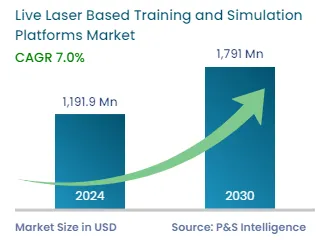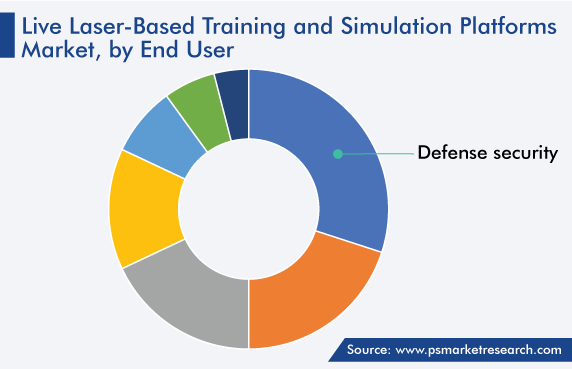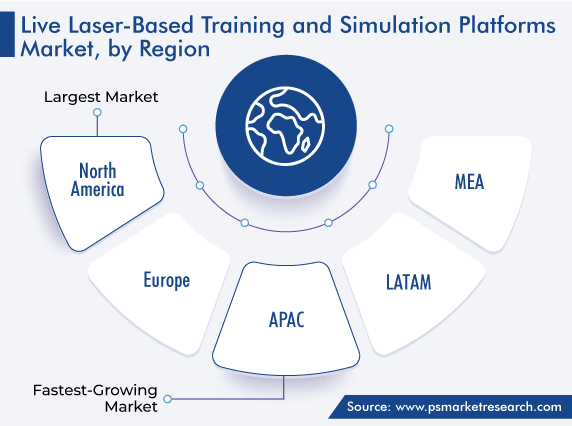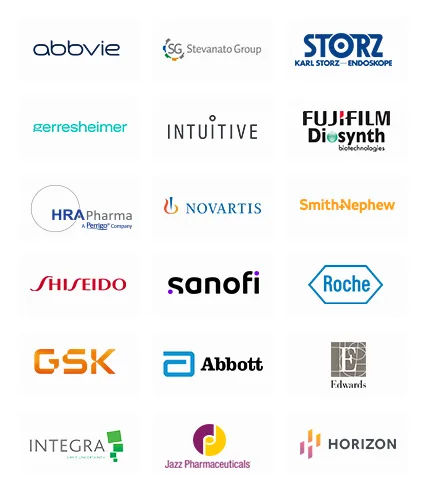Market Statistics
| Study Period | 2019 - 2030 |
| 2024 Market Size | USD 1,191.9 Million |
| 2030 Forecast | USD 1,791 Million |
| Growth Rate(CAGR) | 7% |
| Largest Region | North America |
| Fastest Growing Region | Asia-Pacific |
| Nature of the Market | Fragmented |
Report Code: 12559
Get a Comprehensive Overview of the Live Laser-Based Training and Simulation Platforms Market Report Prepared by P&S Intelligence, Segmented by Component (Hardware, Software), Application (Flight Simulation, Battlefield Simulation and Defense, Medic Training, Vehicle Simulation, Naval Simulation, Ground Simulation), End-User (Defense Security, Civil Aviation, Education, E-Learning, Game-Based Learning, Entertainment, Healthcare), and Geographic Regions. This Report Provides Insights from 2019 to 2030.
| Study Period | 2019 - 2030 |
| 2024 Market Size | USD 1,191.9 Million |
| 2030 Forecast | USD 1,791 Million |
| Growth Rate(CAGR) | 7% |
| Largest Region | North America |
| Fastest Growing Region | Asia-Pacific |
| Nature of the Market | Fragmented |

Explore the market potential with our data-driven report
The global live laser-based training and simulation platforms market was valued at USD 1,191.9 million in 2024, which is expected to reach USD 1,791 million by 2030, growing at a CAGR of 7% between 2024 and 2030.
These platforms are used for training and gaining live learning experiences due to their cost-effective nature and ability to create lifelike situations, thereby providing crucial hands-on experience in a safe and controlled environment. The rise in air traffic and the number of commercial aircraft, increase in the usage of the internet, surge in the demand for better military training, rise in the adoption of smartphones and other electronic gadgets, significant growth in e-learning enrolment, as it aids pupils in gaining cognitive improvements; and advancements in the virtual training and simulation technology together stimulate the growth of the market.
This positive impact on the market can also be attributed to the significant increase in the awareness regarding the importance of live laser-based training and simulation platforms, rise in the need for live and personalized training, and constant surge in the overall expenditure in the healthcare, education, digital manufacturing, defense, research and development sectors.
Moreover, the increase in the need for defense and security training, due to the rise in the count of political conflicts and incidents of civil unrest, is likely to drive the market. Moreover, the 2.8% decline in the global economic growth rate between the years 2021 and 2022 is likely to act as a contributor to the prosperity of the market, due to these platforms’ low development cost.
Moreover, the high government expenditure, rising need for better, personalized training, time-consuming nature of actual real-life training, and the risks associated with the usage of fuel and other dangerous substances, such as explosives, have increased the inclination of the defense and security sector toward live laser-based training and simulation platforms. Moreover, the rapid advancements in artificial intelligence have improved the efficiency of virtual training and simulation software, which is likely to create lucrative growth opportunities.
On the basis of application, the flight simulation category dominated the market in 2022. This can be attributed to the high risk associated with military and civil aviation, significant rise in the cost of the production of aircraft, increase in the spending on flying actual aircraft, and high-volume consumption of the expensive ATF. Flight simulators assist aspiring and even trained pilots to develop, test, and maintain competency in flying, without risking people or property, and for a lot less money than actual flying lessons entail, by providing immersive, lifelike experiences. Moreover, the rise in war-like situations, for instance, the invasion of Ukraine by Russia, has led to an increase in the investments in military aviation, which will continue to contribute toward the growth of the category in the future.
On the basis of end user, the defense and security category held the largest market share, of more than 28%, in 2022. This can be attributed to the growing frequency of conflicts over borders and natural resources. For instance, Russia’s invasion of Ukraine has led the government of various countries to focus on modernizing their armed forces, which, in turn, has influenced the market positively. Military equipment, such as firearms and tanks, are of high importance for land warfare, but their usage during training results in high operational costs and even the risk of injury or death. Due to this, the inclination of militaries toward live laser-based training and simulation has risen considerably.
Additionally, the civil aviation category is expected to witness a CAGR of 6.8% over the forecast period, on account of the rise in air traffic, high operational costs of aircraft, and risk from training on the real thing to human life.

Companies are investing in technologically advanced products that can help healthcare practitioners enhance their surgical skills. For instance, in April 2020, FundamentalVR expanded Fundamental Surgery, its educational platform. @HomeVR, the new education modality of the platform, offers procedural simulations compliant with the guidelines of the Royal College of Surgeons of England and the American Academy of Orthopaedic Surgeons on standalone VR headsets, including the HTC Vive Focus Plus and Oculus Quest. The launch of @HomeVR extends the capabilities of the HapticVR modality for more-flexible and cost-effective training and development.
Moreover, in May 2021, a new version of the CAE Vimedix simulation platform, the CAE Vimedix 3.2, was released by CAE Inc. It includes enhanced fidelity, 3D/4D ultrasound, ultrasonography realism, and multiplanar reconstruction training features. Emergency medicine, cardiology, intensive care, and OB/GYN are among the specialties that can learn about ultrasonography remotely with CAE Vimedix 3.2. The system also offers new capabilities for virtual lectures with quick lesson building, supplementary ICCU e-Learning, interactive sessions, and hands-on practice utilizing a manikin and ultrasound probes. It has a library of more than 200 pathologies.
Additionally, Oxford Medical Simulation, a firm based in the U.K., raised roughly EUR 2.4 million in October 2022 for imparting VR healthcare training. The business seeks to address the pressing need for more-effective nurse and doctor training and assist in resolving the present staffing crisis in the healthcare industry. Healthcare professionals are trained on the platform utilizing hundreds of clinical scenarios and immersive VR simulations with AI-controlled patients. Through practice in virtual consultations, emergencies, and procedures, learners can train whenever they need to, without running the risk of putting their patients’ lives in danger. These simulations not only improve the quality of training but also make it possible to train a greater number of healthcare professionals in less time and for less money.
Moreover, with the advent of robot-assisted surgeries, medical procedures are demanding higher proficiency, which can be achieved through continuous practice with surgical simulation products. Thus, the increasing focus on higher surgical accuracy is resulting in the development of advanced simulation products, which, in turn, is driving the growth of the market.
Drive strategic growth with comprehensive market analysis
In 2022, North America accounted for the largest revenue share, of 36%, in the live laser-based training and simulation platforms market. This can be attributed to the fact that North America is home to two of the biggest economies in the world, both of which are also technologically advanced; the increasing investments of the regional governments in research and development also augur well for the market. For instance, the U.S.’s funding for military R&D increased by 24% between 2012 and 2021, as per the SIPRI.
Moreover, the increasing focus of the U.S. and Royal Canadian air forces on reducing the training cost and time, by bringing down the number of required flying hours, will propel the growth of the market. F-35 aircraft simulators, Live Training Transformation (LT2) systems, F-16 training systems, and long-range strike bomber simulators are used by the USAF to help pilots improve their navigation abilities, prepare them for emergency situations, and develop radio skills, to ultimately make them more proficient, by maximizing their training.
In addition, the rising adoption of these platforms in the healthcare industry due to the significant rise in the burden of chronic illnesses, increasing consumer awareness regarding early disease diagnosis and enhanced patient care, strong government support, and technological enhancements drive the uptake of these solutions in the region.

Based on Component
Based on Application
Based on End-User
Geographical Analysis
Over time, the top players have increased their investments in the innovation of products, to improve the quality and experience of working with virtual training and simulation systems. Moreover, these players have expanded opportunities for themselves via strategic collaborations and partnerships, and they are now launching new products to gain a larger market share in the industry.
Want a report tailored exactly to your business need?
Request CustomizationLeading companies across industries trust us to deliver data-driven insights and innovative solutions for their most critical decisions. From data-driven strategies to actionable insights, we empower the decision-makers who shape industries and define the future. From Fortune 500 companies to innovative startups, we are proud to partner with organisations that drive progress in their industries.


Working with P&S Intelligence and their team was an absolute pleasure – their awareness of timelines and commitment to value greatly contributed to our project's success. Eagerly anticipating future collaborations.
McKinsey & Company
IndiaOur insights into the minutest levels of the markets, including the latest trends and competitive landscape, give you all the answers you need to take your business to new heights
We take a cautious approach to protecting your personal and confidential information. Trust is the strongest bond that connects us and our clients, and trust we build by complying with all international and domestic data protection and privacy laws
Customize the Report to Align with Your Business Objectives
Request the Free Sample Pages